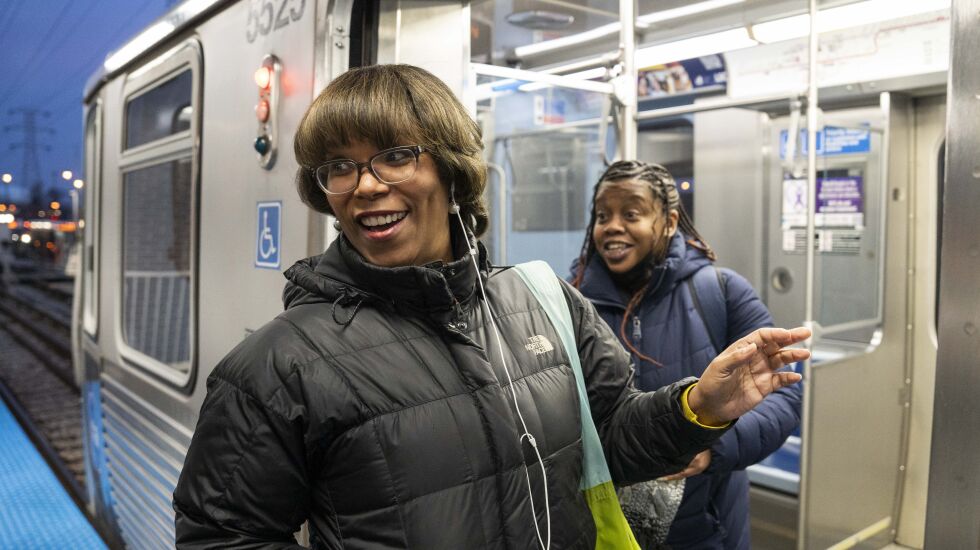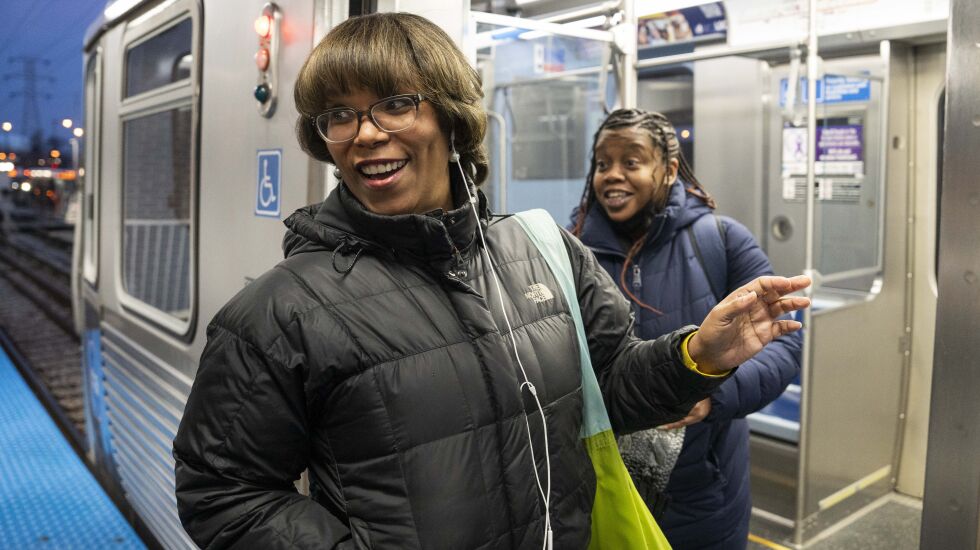
In the still, dark moments before dawn Friday, a familiar voice echoed on the CTA Howard platform: “This is a Yellow Line train to Dempster - Skokie.”
It was the first time that commuters heard the announcement after a Yellow Line CTA train rear-ended a snowplow Nov. 16, injuring dozens and halting service for weeks, causing hurdles for frustrated and nervous travelers.
“CTA has extensively examined all aspects of Yellow Line operations, from tracks and signals to train operations and communications,” a news release from the CTA reads. “Several test trains have run along the line, over multiple days in various weather conditions.”
The November crash injured 38. — were taken to hospitals and three were listed in critical condition. Fifteen people declined medical attention at the scene.
On the Dempster platform Friday morning just before 7 a.m., Ardeth Gardiner pushed through the turnstile to a jubilant greeting from her friend and coworker Shanesha McCray.
“The trains are running!” McCray yelled, laughing.
The two Chicago Housing Authority employees have been taking the Yellow Line to work downtown for years, and the service suspension was a rude interruption. Both women said they added 30-35 minutes to their commute each way, meaning they’d often come home from work 12 hours after they left the house.
“When you get done with work, you just want to come home,” McCray said. “The struggle is real.”

Friday morning, bundled up commuters hustled between the Yellow Line, which connects north suburban Skokie to the rest of the city, and the Red and Purple Lines at the Howard stop in Rogers Park.
The National Transportation Safety Board is still investigating the crash, and a full report is expected later this year. The board’s chair, Jennifer Homendy, previously told worried commuters that rail transportation is “incredibly safe” — safer than traveling by car.
The CTA has increased safety measures “out of an abundance of caution” when reopening the line, including power washing the lines and clearing them of residue and debris, increasing communications, and reduced speed.
The maximum speed has been reduced from 55 miles per hour to 35 miles per hour, and 25 miles per hour in the area where the crash happened near the Howard stop, according to Dorval Carter, president of the CTA. It’s unclear how long the interim safety measures would be in place, and updated routine cleaning and maintenance has been added, Carter said.
While Carter said he understood commuters’ frustration waiting for the train to return to regular service, it was necessary to wait that long to ensure the train was safe.
“We would only make this decision after we had absolute confidence that we could do so safely,” Carter said while addressing reporters at the Oakton train stop Friday. “I will never, never compromise safety for expediency.”
The CTA assessed the train lines to make sure none of them had similar elements that could have led to the crash, like track conditions and signal systems, Carter said, stressing the cause of the crash is still under investigation and that only limited information can be released.
The interruption “created a significant inconvenience” to riders and service resuming was “very welcome news” to commuters who use the train, which provides more than 1,000 rides per day, Skokie Mayor George Van Dusen said at the press conference.
McCray and Gardiner had gotten off the Yellow Line just a few hours before the crash in November and heard the news reports while at work, they said.
“We had literally gotten off the train around 7 that morning,” McCray said. “It’s strange, how did that happen?”
In the absence of regular Yellow Line service, a shuttle has been running between the stops. The shuttle service was scheduled to end as train service resumes, according to the CTA. Service was initially estimated to restart after about a week, but ended up taking nearly two months.
Rob Powell was among other Friday commuters who reflected on the ordeal.
“To have to take the shuttle, it’s inconvenient,” said Powell, who usually takes the Purple Line to Evanston but occasionally rides the Yellow Line. “It does bring a headache. It’s like, ‘Why am I rerouting?’”
While the shuttle had been a pain for some commuters, others, like Allison Tai, didn’t mind so much.
“The yellow bus is very close to the Howard station, so it’s just a few more steps,” said Tai, who works at a bank downtown.
McCray, Gardiner and Tai all said they’re not too worried about another accident coming their way.
“Overall I think it’s still safe,” Tai said. “This is the most efficient way, it would be too difficult to drive.”
At least one passenger on the train during the crash has sued the CTA in Cook County Circuit Court. Cleon Hawkins, a 52-year-old Chicago man who was hospitalized after the crash, alleges in a lawsuit that the “commuter train was operated negligently,” according to a news release issued by the firm representing him, Clifford Law Offices. Even after reopening, the firm is pushing for more answers.
“The public remains in the dark, and the CTA needs to be more transparent so the passengers can have more confidence riding on the Yellow Line,” Joseph T. Murphy, a partner at the firm, said in a news release following the line reopening.
ning.











